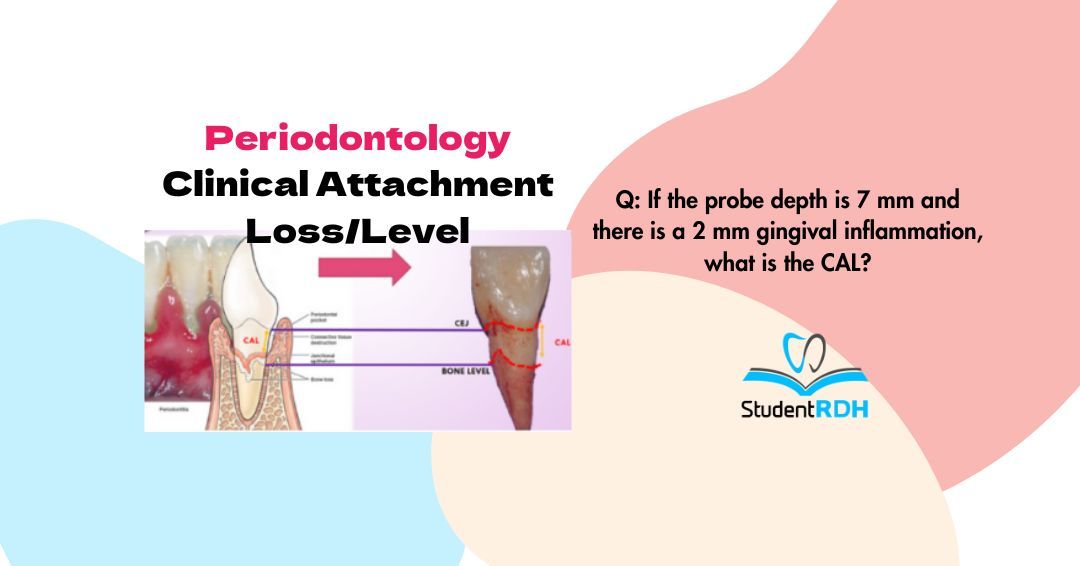Q: If the probe depth is 7 mm and there is a 2 mm gingival inflammation, what is the CAL?
Feb 21
/
Claire Jeong, RDH, MS

Q: If the probe depth is 7 mm and there is a 2 mm gingival inflammation, what is the CAL?
(A). 2 mm
(B). 5 mm
(C). 7 mm
(D). 9 mm
Keyword: Inflammation
Clinical attachment level or loss (CAL) is a more accurate indicator of the periodontal support around a tooth than probing depth alone. CAL is measured from a fixed point on the tooth that does not change — the CEJ.
To calculate CAL, use:
- Recession (gingival margin is below CEJ): CAL = probing depth + recession
- Tissue overgrowth (gingival margin is above CEJ): CAL = probing depth − gingival overgrowth
In this case, recession is present:
- Probing depth = 7 mm
- Recession = 2 mm
- CAL = 7 + 2 = 9 mm
In this case, since inflammation is present, use the formula probing depth (-) gingival margin to the CEJ (subtract). This gives us 7 mm – 2 mm = 5 mm.
Answer: (D). 9 mm
CAL is an important concept we MUST know for the Dental Hygiene Board Exams (NBDHE, NDHCE). And if you are taking the CSCE (ADEX), you MUST master it! I created a video about this on the StudentRDH YouTube Channel. Make sure to subscribe to get more videos, and watch me explain CAL today! I draw the concepts as I explain them.
Learn more for the dental hygiene boards
Now, let’s think about the opposite and consider the situation with a 2-mm recession. What would your answer be then? You probably guessed correctly! You have to use this equation: probing depth + gingival margin to the CEJ (add). In this case, it would be 7 mm + 2 mm = 9 mm.
I find most students merely memorize the equation for the Dental Hygiene Board Exams (NBDHE, NDHCE), but please try to actually understand the concept by either watching the YouTube video or drawing the concepts whenever you see a practice question. As a #RDH or #FutureRDH, we are visual learners, so seeing the drawing of the tooth and the measurements will ensure you don’t make mistakes on your big day (NBDHE, NDHCE). We need all the points we can get to successfully PASS the exams!
Email our team at anytime at support@StudentRDH.com, or if you are interested in the StudentRDH Dental Hygiene Board Exams Review, start with the FREE trial. We don’t ask for your credit card number, so you can start with peace of mind that you can decide later if you like our STEP-by-STEP review process.
Have another great day, #RDHStrong.
Now, let’s think about the opposite and consider the situation with a 2-mm recession. What would your answer be then? You probably guessed correctly! You have to use this equation: probing depth + gingival margin to the CEJ (add). In this case, it would be 7 mm + 2 mm = 9 mm.
I find most students merely memorize the equation for the Dental Hygiene Board Exams (NBDHE, NDHCE), but please try to actually understand the concept by either watching the YouTube video or drawing the concepts whenever you see a practice question. As a #RDH or #FutureRDH, we are visual learners, so seeing the drawing of the tooth and the measurements will ensure you don’t make mistakes on your big day (NBDHE, NDHCE). We need all the points we can get to successfully PASS the exams!
Email our team at anytime at support@StudentRDH.com, or if you are interested in the StudentRDH Dental Hygiene Board Exams Review, start with the FREE trial. We don’t ask for your credit card number, so you can start with peace of mind that you can decide later if you like our STEP-by-STEP review process.
Have another great day, #RDHStrong.
🧠 GET A FREE RDH Study Time Management Guide! 🧠
Related Article: What Is It Like To Be A Dental Hygiene Student
(Disclaimer: StudentRDH is NOT affiliated with the NBDHE, NDHCE, CSCE, CDCA, WREB.)
Subscribe to our newsletter
Thank you!
Policy Pages
Copyright © 2025
